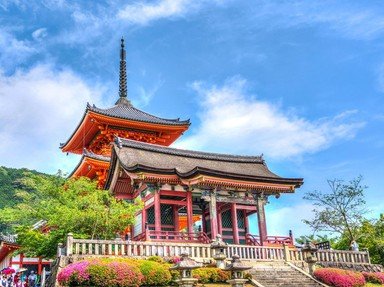Quiz Answer Key and Fun Facts
1. Which city hosts a World Heritage collection of temples and shrines, including Kiyomizu Temple, Ginkaku-ji Temple, and the Shimogamo and Kamigamo Shrines?
2. Todai-ji Temple (with its giant Buddha), Yakushi-ji Temple, and Kasuga Shrine are a few of the monuments that make up the "Historic Monuments of Ancient..." which city?
3. The first World Heritage cultural site for Japan sits in Himeji, and is one of finest Japanese examples of which of these structures?
4. Almost every tourist pamphlet includes a shot of a red Shinto gate, "floating" in the ocean. This is the gate of Itsukushima Shrine, but on which small island is it found (which is often the name that this site is referred to)?
5. Some of the world's oldest wooden buildings can be found at the World Heritage site in the town of Ikaruga, outside of Nara. What is the name of this ancient temple?
6. The Tosho-gu Shrine in Nikko, 140 km north of Tokyo, houses the mausoleum of who?
7. Drive to the mountain villages of Shirakawa-go and Gokayama to see the "homiest" of Japan's World Heritage sites. The houses in this area are built in the Gassho-tsukuri style, and meant to withstand the heavy snows of winter. What is the most distinctive feature of the house?
8. Japanese is often seen as a homogenous society, but there are many indigenous cultures that have been incorporated into the country's political boundaries. The Chinese-influenced Gusuku (Castles) of __________ harken back to the glory of this former Kingdom, and was included as a cultural World Heritage Site in 2000.
9. Not all World Heritage preserves ancient history. The Genbaku Dome stands as a reminder of the terrible things that war brings to a country. In which city can you see the ruins of this building?
10. Japan's newest World Heritage site was listed in 2007. What kind of site is Iwami Ginzan, located in Shimane Prefecture?
Source: Author
lykita
This quiz was reviewed by FunTrivia editor
Bruyere before going online.
Any errors found in FunTrivia content are routinely corrected through our feedback system.
